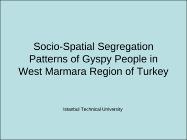Socio- Spatial Segregation and Integration Patterns of Gypsies in City life: The case of West Marmara Region of Turkey
Citation
• Erkut, Gulden, Çakirer, Yasemin, 2005, “Socio- Spatial Segregation and Integration Patterns of Gypsies in City life: The case of West Marmara Region of Turkey”, Annual Gypsy Lore Society Meeting and Congress, 9-10 September, University of Granada, SPAIN.Abstract
This paper has two main objectives. First objective is to find out, whether the Gypsies are socio-spatially segregated from the majority groups in urban areas or not. Second aim is to analyze the pattern and process of this socio-spatial segregation. The ideas of social polarisation and spatial segregation in Western cities are by now widely known. According to ecological theory, residential location of groups is linked to its socio-economic status as well as their ways of living. Thus, it may be said that there is unbridgeable gap between two worlds; The Gypsy and The Gadje (non-Gypsy) in most of he European cities. Today, all over the world Gypsies have different sedentarial behaviours. They prefer different locations to live according to their cultural, economical and political heritage. Such as; - the ourskirts of the city - (near or) in the rural area - the central district of the city - the outside of the inhabited area This paper will be based on several case studies within different settlements of West Marmara Region in Turkey having different types of locational choice. The selection criteria of sample localities depended on the concentration of Gypsy population in that urban areas.
Collections
- Mimarlık Bölümü [152]



















